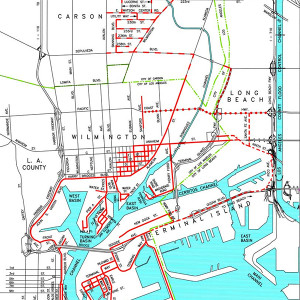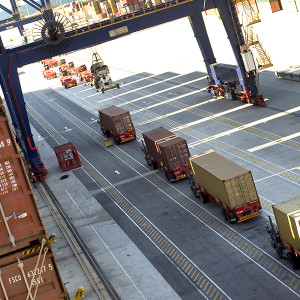 Established in 1994 by then Assembly Member Betty Karnette, the Overweight Corridor (OWC) provides the Ports of Los Angeles and Long Beach a much-needed route for overweight trucks to legally transport cargo containers on State Route 47/103 and Highway Route 1 (Pacific Coast Highway).
Established in 1994 by then Assembly Member Betty Karnette, the Overweight Corridor (OWC) provides the Ports of Los Angeles and Long Beach a much-needed route for overweight trucks to legally transport cargo containers on State Route 47/103 and Highway Route 1 (Pacific Coast Highway).
The Ins and Outs of the OWC
Strategically located in Los Angeles County, the OWC allows distributors with proper permits and equipment to transport 40’+ containers weighing up to 95,000 pounds to nearby distribution centers, industrial complexes, and the Ports of Los Angeles and Long Beach.
7 Million Square Feet of Additional Industrial Space
As trade volumes at the ports have steadily increased, the initial corridor needed to be expanded to keep up with trade demand. In September of 2011, AB1128 was signed into law, giving the city of Carson the jurisdiction to implement an extension of the Overweight Corridor. This extension allowed overweight transport on Alameda Street North, Sepulveda Boulevard, and Wilmington Avenue.
Through the availability of an additional 7 million square feet of industrial space located in and around the thriving cities of Carson, Los Angeles, and Long Beach the extension provides enormous benefits for international trade and local economic expansion.

Shipping More Efficiently
The OWC’s most significant benefit from an operational standpoint is reduced transportation costs: With heavier cargo allowances, more goods can be packed into fewer containers, which means lower shipping costs. With fewer shipments being made, the environment directly benefits, as there are fewer emissions being released into the atmosphere. The ports and surrounding areas can enjoy improved traffic conditions, with fewer trucks congesting these already bustling routes.
A Critical Route for Efficient Global Distribution
Today more than ever, the OWC plays a critical role for distributors in the Los Angeles area. As trade volumes at the port continue to increase, the OWC provides a means to keep up with international trade demand while expanding local operations: Distributors can more quickly and efficiently move cargo from distribution centers to the ports to the global market. Heavier cargo loads mean fewer shipments, which in turn means lower costs.

Permits and Proofs
It is important to note that permits are required to take advantage of the OWC. Various agencies control the routes within the OWC, each of which is responsible for issuing permits. When transporting cargo through multiple cities, each jurisdiction requires a separate permit. In addition to proper equipment based on the cargo weight, worker’s compensation insurance and CHP Vehicle Inspection Reports may be required, depending on the shipping route.
Heavy Cargo’s Pass to the Global Market
Leasing a distribution center within the OWC provides premier access to the global market along with lowered costs and increased speed. With the continual increase in trade activity at the ports, the advantages of the OWC are a critical point to the strategic success of any distributor, logistics company, supply chain provider, 3PL, or shipping company. Put simply, the OWC gives heavy cargo VIP access to the world economy.
Find out what a distribution center within the OWC can do for your business’s global presence: Visit www.overweightcorridor.com today.








